Marvel8ed
Webdesigns
My Woodturning Experience
In 2010, I visited my over-55 (retirement) village's woodshop, to start making a built-in desk. I had designed the desk to extend entirely across one end of our second bedroom. I wanted the top of the desk to be 30-inches deep. The length of the desk would be 12 1/2 feet, and one end would have a 45-degree angle to match the wall. I was at the woodshop with considerable trepidation. I was about to tackle the biggest cabinetmaking job I'd ever done.
I had contacted several cabinetmakers, and they could all build my desk, but every one of them wanted to install pre-made drawers, about 17 inches deep; whereas, I wanted the drawers to all be 27 inches deep, to utilize all the space available in a 30-inch wide desk. Why waste 10 inches of useable space in each drawer? Everybody is always short on drawer space, so why waste the opportunity to gain more? I got frustrated talking to these cabinetmakers who had the term "Custom" in their title, but they didn't really want to do custom work. They just wanted to charge custom prices ($1500 to $2000) but use prefabbed drawers. So I decided I'd make the desk myself! That is why I first visited our village's woodshop.
As it turned out, my worries were unfounded. I made the desk exactly as I wanted, and my total cost was about one-fifth the average bid from the cabinetmakers. I had a lot of fun doing this project, and I met a whole bunch of woodworking guys who thought a lot like me (you can read that as "kinda geeky"). I was hooked on the woodshop.
So, I kept going back to the woodshop. My next project was a fly-tying bench, because I am a fly fisherman, and I enjoy tying my own flies. I liked my first bench; but what if I made another one with a cover that turned the bench into a portable fly-tying case for when I travel? Well, I made that one too, and was really pleased with it. But, after using it awhile, I realized that a few design improvements would really make it neat; so I built a third one! This last one is all I will ever need; I was content with it. The first two were given away, and I made some other flyfishers happy too.
What to do next? I really didn't have any other woodworking plans or ideas in mind, but I didn't want to quit going to the woodshop! There were too many really interesting men to talk with and they were doing some pretty neat stuff, and I was so happy to have every tool a woodworker could dream of readily available to use. The woodshop was, in my mind, one of the major benefits of living in a planned retirement community. Of all the equipment in the woodshop, what really interested me the most was the wood lathes. We had several good woodturners, and the work they were turning out really interested me.
Our woodshop had three lathes, and the woodturners were keeping them busy, turning out bowls, vases, canes, platters, and pen-and-pencil holders. I thought this would be something I could really enjoy. I love the grain and texture of woods more than the shape of the furniture that the wood goes into. In woodturning, the form is more free-flowing than in flat work, and the same piece of wood turned by 10 different turners will look completely different in the finished product, based on the way the wood was oriented with respect to its grain, the shape of the item, and the finish applied. I was well aware of the artsy potential before I ever picked up a woodturning gouge.
Well, I asked one of the woodturners to give me an introduction to the use of one of our woodshop's lathes. He showed me how to mount a bowl blank on a faceplate, and how to use an Oland Tool to scrape the bowl into shape, and also gave me several basic safety tips.
In retrospect, I'm glad I was started out with an Oland Tool scraper instead of
a bowl gouge. The learning curve is far briefer, and I turned out a very nice bowl
on my first try! It was a small, spalted, curly-maple bowl, dished out to hold paperclips
for my desk.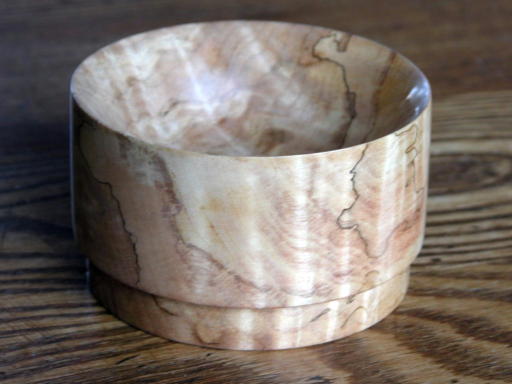 I was addicted.
I was addicted.
Since then, I have graduated to using a bowl gouge about 90-percent of the time, and I really love its efficiency and clean, shearing cuts. But, I continue to think that beginners need to start out using an Oland Tool or similar scraper, so their learning curve is not so discouraging. For me it was a simple progression, with none of the discouragement so many new woodturners experience. And I attribute this almost exclusively to starting out with very forgiving tools.
I recognize that some new turners will never "graduate" from using the Oland Tools. They get the results they desire using a tool they're comfortable with, and they see no reason to learn the more difficult bowl gouge. Some advanced woodturners really frown on this approach, and not without some good reason. The bowl gouge is indisputably better, in the hands of a well-trained woodturner. Bowl gouge advocates, therefore, believe everyone should either "graduate" to the bowl gouge, or even start out with it. I strongly disagree. Woodturning is supposed to be a fun, one-person endeavor, not a team sport, and not necessarily a competition. If you personally gravitate to the competitive approach, great; but don't lay your expectations on other woodturners.
I think that Jimmy Clewes, a master woodturner from England, gets it right. He scoffs at those who insist there is only one way. Jimmy says once a bowl is fully finished, the best turner in the world cannot tell if it was cut with a gouge, skew, or scraper. He says that whatever method you are content with, and whatever method gets you to your goal is what you should do. He encourages students to learn how to use the gouge, but he doesn't make a religion out of it. He says woodturning is supposed to be fun, and fun is what makes you happy.
That is not to say that it is wrong to push yourself to always learn more. It is just to say that some folks don't want to do that! And that is not wrong either, if the woodturner is content. I know one woodturner in our retirement village who has been turning for about a decade, and he still turns out utilitarian, straight-vertical-wall bowls -- by the scores. And he is as happy as can be; and family and friends love to get his gift bowls. Is he wrong? Heck no! He really enjoys his woodturning, he is proud of his work, and he is happy. That is more than some of the more uptight turners can say. And you know, his curves don't flow, 'cause there aren't any; the bowls don't have the magic proportions; but they still look professionally done (clean lines and great finishes); they please him; they please those who get them, and there is room for art that doesn't fit our expectations!
I have told him and many other of my friends that if I ever went into business selling
my woodturnings, I'd name my company, "Half-Cracked Woodturnings,"
because I like the non-utilitarian, artsy stuff, with the natural cracks left in
the turning -- and even accentuated.
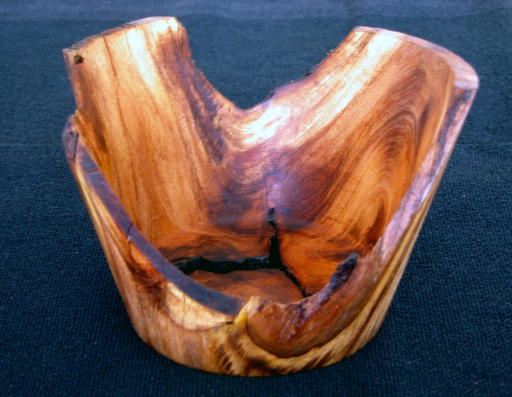 My utilitarian friend doesn't understand why I'd like a bowl with a hole in its
side! I just laugh; it is this diversity of taste that makes our World so rich in
variety. There is no RIGHT way. The way that professional woodturners have
agreed upon is merely a formalizaton of a majority view (of a select personality
type that favors conformity) in which this same majority agrees to declare this
view "best." If you choose to say, "Nah, that is not what I like." more power to
you! You should turn what you like -- if it is for yourself.
My utilitarian friend doesn't understand why I'd like a bowl with a hole in its
side! I just laugh; it is this diversity of taste that makes our World so rich in
variety. There is no RIGHT way. The way that professional woodturners have
agreed upon is merely a formalizaton of a majority view (of a select personality
type that favors conformity) in which this same majority agrees to declare this
view "best." If you choose to say, "Nah, that is not what I like." more power to
you! You should turn what you like -- if it is for yourself.
This please-yourself view is liberating. It is, that is, unless you hope to sell your products. Then you must please your customer first. You have to make what your customers are attracted to, which is often not what you're attracted to, and often not what the artsy community is attracted to. Thick walls sell! Super-glossy finishes sell! And that is good. But, this difference between turning to please myself or to please a customer is exactly why I don't normally sell my work. If someone sees one of my turnings that they obviously just have to have, then I'll set a price on it, but normally my work is not for sale, because I want to do it for myself.
I don't present anything I do as "measuring up" to some standard. Almost everything
I do I'd do a bit differently if I were to do it again. Some of the turnings I treasure
the most are ones that are far from perfect, but they were a milestone in my learning
process. Heck, I even keep the remnants of my turnings that exploded on the lathe!
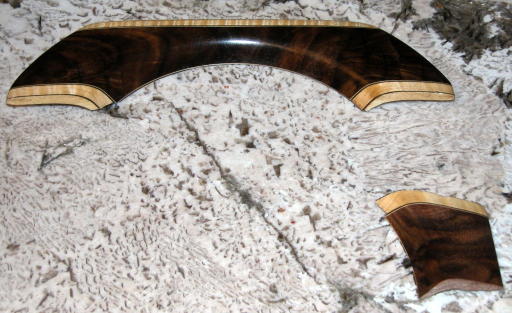 I had this gorgeous curly walnut winged bowl almost finished, and the walls were
only one-eighth inch thick. I wass extremely happy with it. And I lost my attentiveness
at the wrong moment, and this gorgeous bowl became fragments in milliseconds. I
keep it to remind me of what "almost was!," and to remind me to keep focused.
I had this gorgeous curly walnut winged bowl almost finished, and the walls were
only one-eighth inch thick. I wass extremely happy with it. And I lost my attentiveness
at the wrong moment, and this gorgeous bowl became fragments in milliseconds. I
keep it to remind me of what "almost was!," and to remind me to keep focused.
Some projects turn out better than planned; but I can still see things I would do
differently next time. A friend gave me the ground-level stump of an Alligator Juniper
that had been standing dead for about 20 years. The outside was weathered to a beautiful
gray; and the inside was still sound and gorgeous. As I studied it, I realized I
could not improve on what the weathering and the worms had done to the outside,
so I decided to preserve the outside as a huge "natural edge." I'm so glad I did.
I even left the part of the stump that had been turned brown by being below dirt
level. It definitely adds to the piece's appeal to me. I felt like I exposed the
hidden inner beauty to the evident beauty of the outside, and I was happy.
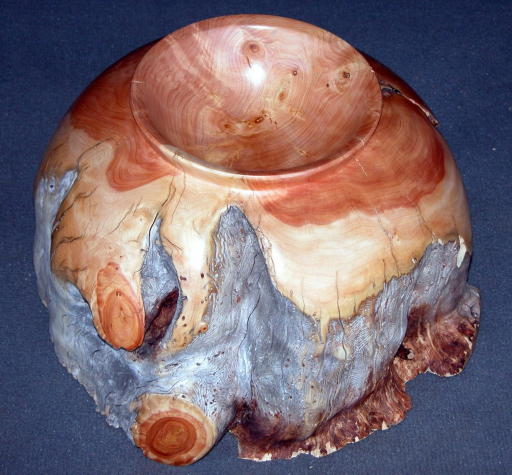
I was, as I said, quite happy with this piece. But a woodworking friend saw it and asked if I was finished with it? I thought he was being funny; but when I looked at his face I could see he was not joking. I said, "Yes." He said, "Why don't you do something more with that huge, heavy base? At first I thought I'd just ignore his advice; but the more I thought about it, the more it made sense to me.
He was, of course, correct. The little bowl I'd turned into the top was really small with respect to the base which was still 6 1/2 inches thick. So I needed to do something more with the base. But I didn't want to remove any of it; and deepening the bowl would not look good. So what to do?
After considerable consternation, I decided I could rework the bottom by chucking
this huge piece of wood in Cole Jaws, using the little bowl's rim as the chucking
point. I could get a really firm grip on the rim, but there was a heck of a lot
of heavy wood hanging out there trying to rip it out of the rubber-coated Cole Jaws.
So I knew I'd have to keep the live center in place until 99.5 percent of the new
cutting was finished, and I dare not get a catch! I rechucked it in the Cole Jaws,
took a big deep breath, told myself to make no mistakes, and turned a second bowl
in the bottom of it, making two bowls in one piece.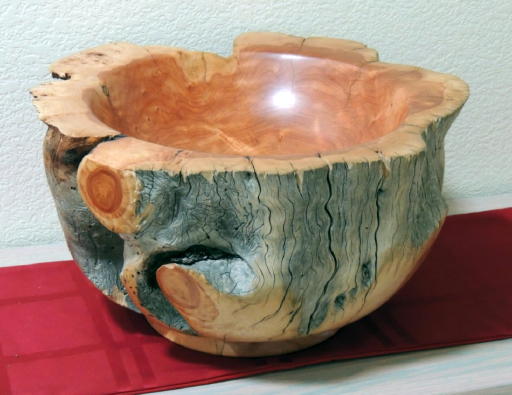 I kept the speed way down, kept the gouge ultrasharp, and worked slowly and carefully.
It worked out better than I expected. Now, I can display the top bowl for awhile,
then turn it over and display the bottom bowl for awhile. Folks who see it either
love it or hate it. It is my favorite turning so far. It doesn't display any super-technical
proficiency, because it was relatively easy to do. But it does do exactly what I
wanted with respect to the art and the wood. And that is sufficient for me.
I kept the speed way down, kept the gouge ultrasharp, and worked slowly and carefully.
It worked out better than I expected. Now, I can display the top bowl for awhile,
then turn it over and display the bottom bowl for awhile. Folks who see it either
love it or hate it. It is my favorite turning so far. It doesn't display any super-technical
proficiency, because it was relatively easy to do. But it does do exactly what I
wanted with respect to the art and the wood. And that is sufficient for me.
Once my neighbors knew I was a woodturner, I "trained" them to keep their eyes peeled for wood to supply my addiction. They learned, by word of mouth, from other neighbors (I never promised anything) that if I got a nice piece of wood from them they'd soon get part of it back as a bowl, or something else that made sense from the piece. I've received some interesting wood this way! And my neighbors are happy to be on the lookout for wood for me.
One piece had quite a history. My neighbor visited a cousin in Tennessee, and saw
his new, beautiful log house. The center support "pole" for the roof was the trunk
of an Eastern Red Cedar tree that his cousin had located in Virginia, and had trucked
all the way back to Tennessee for his house. My neighbor was enthralled with the
house, and asked if his cousin had any leftover wood he could spare for his woodturning
neighbor in Mesa (me)? The cousin said, "Sure, I've got the top few feet left over
from the centerpole of the house; it's out in my barn." They went out and cut me
an 18-inch piece. Here's one of the bowl I turned from it; and my neighbor shipped
it back to his cousin in Tennessee to have inside his log home.
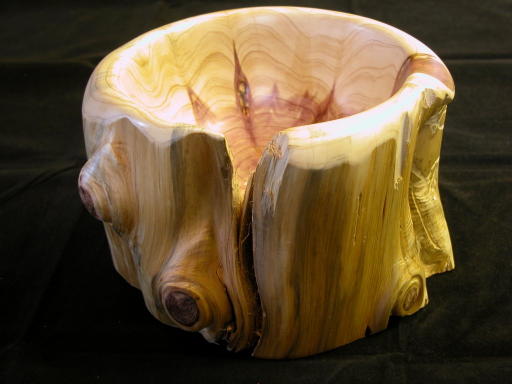
Some people think I should have filled the big split in the side of this bowl. But I resisted. The purpose of this bowl is not to store nuts. It is to show off the hidden inner beauty of the home's centerpole that people cannot otherwise see. And this bowl does it well, split and all! Heck, the centerpole has a few of these kinds of cracks and they look just fine.
Another bowl I did was an experiment with the so-called bandsaw-bowl technique,
where one makes a square, flat board, and bandsaws concentric circles out of it,
and then glues them together to form the shape of a bowl, which is then turned and
finished. I made my experimental bandsaw bowl out of African Lacewood. I cut 1-inch
by 1-inch square stock about 8 inches long. These I glued these all together to
make the 8-inch square by 1-inch thick flat board. The finished bowl isn't very
pretty, in my estimation, but the joinery was pure perfection -- far better than
my normal work.
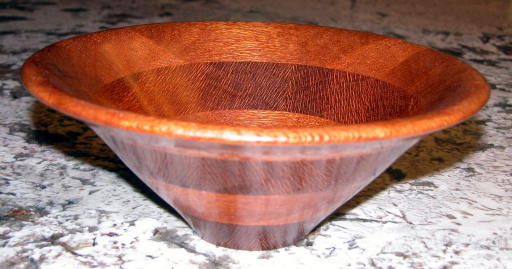 Every joint was purely perfect. It is the only bowl I ever took to
the Arizona Woodturners Association meeting to display. I later gave the bowl away,
because I really didn't like the color or shape, but I sure was proud of the joinery!
And the lady who got it as a gift was very happy with it.
Every joint was purely perfect. It is the only bowl I ever took to
the Arizona Woodturners Association meeting to display. I later gave the bowl away,
because I really didn't like the color or shape, but I sure was proud of the joinery!
And the lady who got it as a gift was very happy with it.
Of course, every once in awhile, I have to mix my interests together. I love flyfishing
and fly tying. One day I saw a commercial hook holder dish made out of brass, and
the crooks wanted almost $30 for it! It was a useful item, but sheesh, why pay that
much for something to hold hooks, when I could easily turn one out of pretty wood
for free? So I did. So far I think I've made over 100 hook holders for my flyfishing
buddies, and they love them. They take about 10 to 15 minutes to make, start to
finish. I finish them with beeswax, heated by friction to melt it into the wood.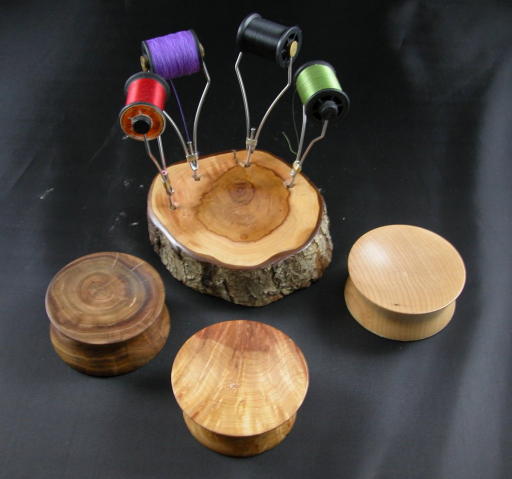 So finishing one of these takes about 30 seconds. Then a flyfishing friend showed
me a similar hook holder that another friend of his had made out of a cross section
of a tree limb, to hold fly-tying-thread bobbins and to also hold hooks! His was not turned
on a lathe. The hook holding depression was made with a routher bit. I thought I
could do as well or better making the same thing on a lathe. So now I make those
too. They take a bit longer, but they're still dead simple to make.
So finishing one of these takes about 30 seconds. Then a flyfishing friend showed
me a similar hook holder that another friend of his had made out of a cross section
of a tree limb, to hold fly-tying-thread bobbins and to also hold hooks! His was not turned
on a lathe. The hook holding depression was made with a routher bit. I thought I
could do as well or better making the same thing on a lathe. So now I make those
too. They take a bit longer, but they're still dead simple to make.
One of the joys of my woodturning experience was FINALLY learning how to turn a natural edge bowl and actually keep the bark on it. I have Michael Hosaluk to thank for this.
The following bowl was made from a 3-inch diameter mesquite limb about 7 inches long. I "centered" the limb sideways, instead of end-to-end, turned a chucking foot on one side, and then turned the bowl out of the side of the limb. It ain't beautiful, but it is my first natural edge bowl that I felt happy about.
My wife immediately claimed it for her kitchen window. It now serves as a "container"
for her jar of hand cream. Sigh! I didn't intend for it to be utilitarian, but my
sweetie Norwegian wife found a way to make it so! Now don't you dare tell her I
said that. Actually, I'm glad she kept it. I didn't want to give this one away.
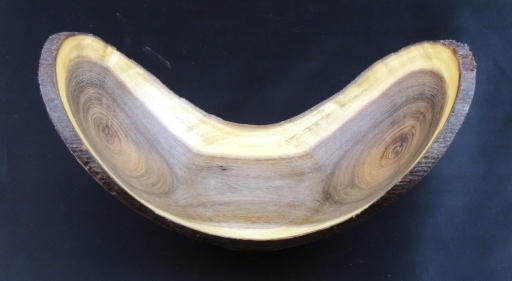
I love woodturning, and I feel like I have the artistic talent for it, but I get frustrated with not always being able to make my tools do what I want, to replicate what I see in my head. Too often I had to settle for an approximation of what I wanted. One of the nice things about woodturning is that lemons can usually be turned into lemonades, which is not nearly as common in flat woodworking. But as the turner, I KNOW when I didn't get it just like I had envisioned. And it bugs me.
So at the National American Woodturners Association Symposium in Phoenix in 2014,
I attended a seminar where some of the nation's top turners were discussing how
aspiring turners can hasten the advancement of their skills. The question of how
to improve tool control came up. The standard answer of "practice, practice, practice"
was given. But one of these turners, Jimmy Clewes, said something different that
really hit home with me.
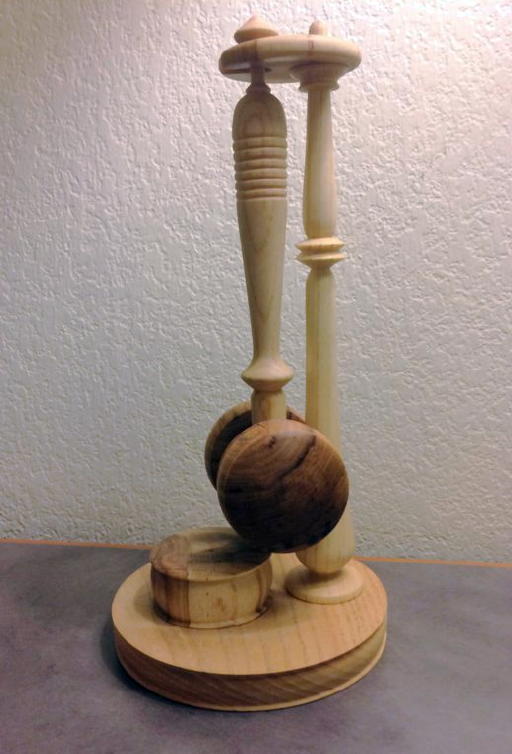 He said that if one is having trouble with tool control, go back to the basics of
spindle turning. He said that the traditional way of teaching wooodturning in England
was to start off with spindle turning, and to not let the student go on to bowl
turning until they had mastered the tool movements and "muscle memory"
for making coves, beads, curves, vees, and the like on spindle projects. He said
once you were good at spindle turning, bowl turning was far easier. He lamented
the loss of this traditional approach.
He said that if one is having trouble with tool control, go back to the basics of
spindle turning. He said that the traditional way of teaching wooodturning in England
was to start off with spindle turning, and to not let the student go on to bowl
turning until they had mastered the tool movements and "muscle memory"
for making coves, beads, curves, vees, and the like on spindle projects. He said
once you were good at spindle turning, bowl turning was far easier. He lamented
the loss of this traditional approach.
Jimmy's comments really rang true with me, so I scheduled a 3-day training session with him, at his studio in Las Vegas, for the purpose of learning spindle turning. I won't claim that I'm even competent at spindle turning yet, but he sure gave me some good instruction, and one heck of a project to work it all out on. The beads on the handle of the gavel purely suck, but then again, it is the first beading I'd ever done. So there. And this whole project was done in 1 day. He worked us hard, and I did four projects in three days. Jimmy does an exceptional job of teaching. I'm going back this coming year for more of his instruction.
Most of the inspiration that keeps me going comes from my membership in the Arizona Woodturners Association. They have great meetings, with extensive demonstrations every month. The membership is large and diverse, and we have a couple of nationally recognized turners and a lot of others who could be if they were so inclined, judging from their excellent work. I always come away from these meetings with a mind full of fresh ideas and inspirations, and a more humble attitude about my own capabilities.
Well, that's about it, so far as words go. A photo archive of all my work is available. I have included in it all the woodturning projects I've done since I started turning in 2011, a few flat woodworking projects as well, and some of the tools I've made; all placed in a picture gallery that you can view here if you're interested.